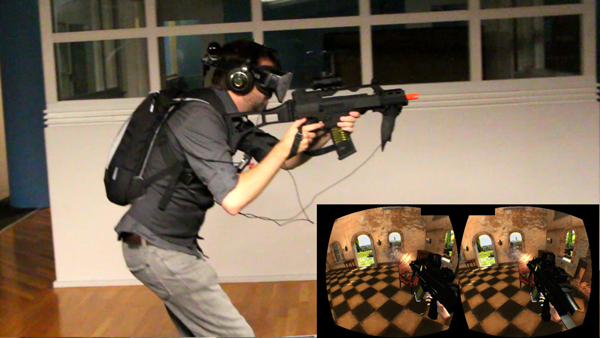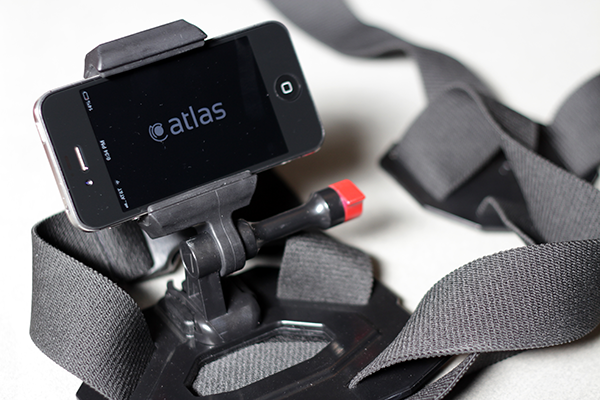Positional tracking is hard. Especially if you want to move through your virtual world as a physical space. Aaron Rasmussen has a solution and it’s an elegant one. His Atlas project promises to make your home a VR playground using your smartphone and printed markers.
“The beginning is a very delicate time.” A quote from Frank Herbert’s Dune which has been rattling round my head recently, specifically with regards to where we find ourselves, here at the dawn of the rebirth of Virtual Reality. The Oculus Rift opened Pandora’s box and out popped 1001 different challenges for developers and inventors to try and solve. The biggest among them, how to allow your body to move around a virtual space along with your mind. Positional tracking is the goal here and we’re a long way from reaching any sort of consensus on how it can be achieved.
Harnessing VR
Aaron has a solution though and it’s an elegant one at that. Everyone has a smartphone, so why not use it for something more than facebooking cat pictures and use it’s processing power and high quality camera to provide high fidelity tracking data. Using special markers that can be printed in the home onto sheets of normal paper, you can layout your own virtual playground on the floor of your living room. When your smartphone is strapped into the Atlas harness, the phone is angled towards the floor. When the Atlas software is loaded into the phone and paired with a backtop (a laptop in a fancy backpack), the markers provide positional information used to track your movements in space. You’ve just built yourself a Holodeck!
Atlas is midway through a Kickstarter campaign, so we wanted to find out more about the system. Aaron was kind enough to tell us more:
Road To VR: Tell us about yourself and Atlas Systems
Aaron: My name’s Aaron Rasmussen, I’m a computer scientist and inventor. Like most of us, I’ve wanted a holodeck since I was a kid. Atlas is a 3d positioning system for VR that is inexpensive, can cover extremely large areas, and is fast and easy to set up.
Road To VR: Would you call yourself a VR enthusiast? What got you hooked?
“As much as Virtual Boy gets panned, I was blown away by it as a kid. There was something so stripped down about the system.”
Aaron: Yes! I’ve been looking at doing a free-roaming/real space VR system for a few years and have been researching various methods. A big problem was the lack of wide FOV HMDs with low orientation latency. As soon as I saw the prototypes of the Rift hit the press, I knew those problems were going to be solved. I tried a Rift in February at IndieCade East, and knew immediately that VR was finally here. As much as Virtual Boy gets panned, I was blown away by it as a kid. There was something so stripped down about the system. Most of the games were just vector based. The simplicity made it feel accessible, like the clockwork was exposed.
Road To VR: What was it that inspired the Atlas project? How did it some to be?
Aaron: I was toying with the idea of Atlas 7 or 8 years ago. The tech was just not there yet. Then a couple years ago, Michael Astolfi and I were working on BlindSide in New York, and he asked if I had unlimited resources what would I work on. I was surprised by how quickly the answer came to me, “The holodeck,” I said. And then I proceeded to explain my plan for it. This set the gears in motion, but I didn’t go full time on it until I tried the Rift.
Road To VR: Chart the history / evolution of the Atlas Project for us.
Aaron: Atlas started as a structured light positioning system using laser grids and dedicated hardware. This looked really cool, but there were some occlusion problems from the projectors, and some specular reflection problems when it was on gym floors where I assume Atlas will mostly be used. I had this great conversation with David Eagleman, a neuroscientist, and found out that I was chasing latency times that were much lower than necessary. This opened up some other possibilities to solve the problem, like lower framerate cameras and lower frequency IMUs.
Road To VR: What sorts of VR experiences do you feel are best suited to Atlas?
“You can imagine going to a basketball court with some friends, setting up, and then having the most amazing game of laser-tag-with-rockets-and-helicopters ever.”
Aaron: I think squad-based multiplayer will be the best. Whether that’s FPS-style games, adventure games, or educational experiences. They need to be specifically designed for Atlas. You can imagine going to a basketball court with some friends, setting up, and then having the most amazing game of laser-tag-with-rockets-and-helicopters ever. But I could also imagine narrative experiences where you all get together to go on a fantasy adventure for an hour every week while getting in better shape. Imagine exploring crime scenes or solving ancient puzzles in real space.
Road To VR: How have you tackled issues such as camera line of sight / occlusion etc?
Aaron: Yes, to some extent. The system is fairly tolerant of occlusion, which should only happen when another player is standing in its path. As long as it can see about 60% of its FOV, it can track. If it can’t, you’re probably standing too close anyways, and it will throw a warning.
Road To VR: Your Kickstarter Goal is $125,000 – what will the money be used for?
Aaron: A very large portion of the money will be used for producing chest mounts/markers/shipping/etc. This is my third Kickstarter campaign, so I have a good sense of what that takes. The rest will be used to move our part time members to full time, and refine the tracking tech to where we want it, make a great SDK, and support the community of developers.
Road To VR: Can you explain in more detail how the tracking system works:
—- How is data transmitted from the phone to the backtop (BT, WLAN, USB)?
Aaron: Right now we use wifi over an adhoc connection to the backtop. It can go through a router, but we’ve experienced some latency issues on many home routers due to QoS algorithms. We are looking to also support bluetooth, and the optimal BT latencies are within range of what we need, but not as good as wifi.
—- What sort of latency times is the system currently exhibiting?
Aaron: It depends on quite a few factors. The biggest issue is the latency between when a photon hits the CMOS sensor in the camera, and when we get that pixel data to work on. It can be 100ms in some cases. It’s surprisingly slow on an iPhone, and why I initially discounted it as a platform for Atlas. Probably 35-40 people have tried the system so far and nobody has noticed latency at all despite being asked about it. Granted, we’re walking fairly slowly, but I’m surprised it isn’t more of an issue.
—- What minimum specs are required for the IOS / Android device?
Aaron: It needs to be an iPhone 4s or better.
—- How few tiles can the system work with (how many need to be visible to the
Aaron: Technically only 1 tile needs to be visible, but for playable tracking, it needs to be at least 3 tiles. Every additional tile makes it better. That works out to about 1 tile per 5-6 feet, which is surprisingly sparse, even in a large area.
—- How sensitive is the system to low-light conditions?
Aaron: The system is an odd reversal of the usual optical tracking dilemma. With a system like the Playstation Move, you need as little ambient light as possible so you can resolve the active bulbs. On Atlas, the more ambient light the better. If it gets too dim, the shutter speed slows and all the frames come out blurry so tracking is very difficult. We have some methods of compensating for that, but low light situations are unusual on any sort of court. It works out well for us.
—- Are you you doing any tweening or prediction to enhance the tracking information to improve the experience?
Aaron: Yes! We’ve tried a number of methods, especially in trying to answer the question “What is the movement update FPS that convinces people they are actually walking around a virtual world?”
Road To VR: Beyond Kickstarter, do you intend for Atlas to be an ‘Everything in the box’ solution (i.e. Rift, Backtop Bag, Gun Replica, Camera Harness etc.)?
Aaron: Right now we want to remain very focused on the positioning technology. I think those solutions will come out, and we’ll be able to snap on to them.
Road To VR: Do you foresee the technology as having the potential to revive public gaming spaces such as Arcades – where people pay to use the system? Or are you more focussed on home use?
Aaron: We are focused more on Atlas working like a set of tennis rackets, a basketball, or a football. You take it somewhere with friends to play. That way everyone has access to it, can play as much or as little as they want, and it helps utilize many spaces which might otherwise be unoccupied. There is definitely potential for arcades, especially for people who want to try it out, but it’s not our focus. Home use is less likely, because your living room is just not that big. Well, mine isn’t.
Road To VR: Pick a game you’d love to play in Virtual Reality with the Atlas system.
Aaron: I know it doesn’t sound very innovative, but the game I really want to play on Atlas is Gun Game. Whether it’s the Blops1, Blops2 or Counter-Strike version. That would give me an insane workout without having to think about, especially if you have to run back to your spawn point. I would last maybe 2 games and then be done for the day. My guess is that the game I’ll like the most is one someone else develops that I never saw coming.
Road To VR: You should consider a Rocketeer themed Backtop / harness system. Just sayin’
Aaron: I would LOVE that. Especially if the HMD looked like the helmet :-)
Our thanks to Aaron for sparing the time to answer our questions. You can find out more and become a backer of Atlas here.








